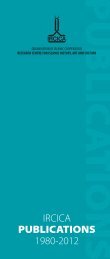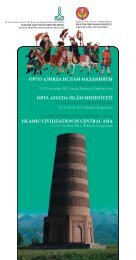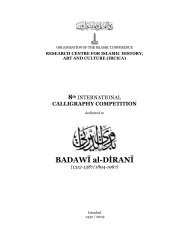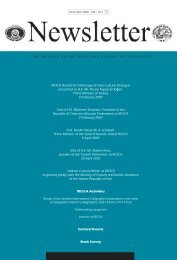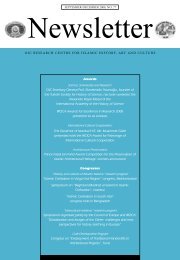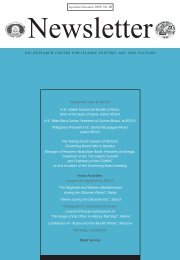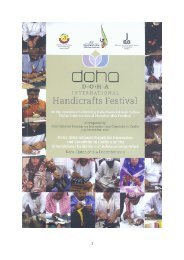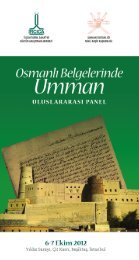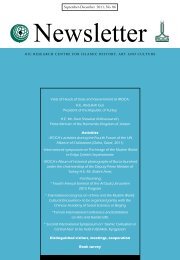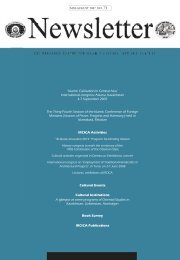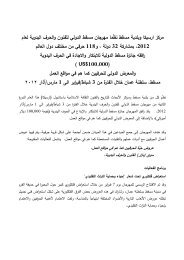oic research centre for islamic history, art and culture - ircica
oic research centre for islamic history, art and culture - ircica
oic research centre for islamic history, art and culture - ircica
- No tags were found...
Create successful ePaper yourself
Turn your PDF publications into a flip-book with our unique Google optimized e-Paper software.
IRCICA’s p<strong>art</strong>icipation in the “Saudi Arabia Cultural Days”22-28 October 2007IRCICA ActivitiesIRCICA hosted a series of lectures within the frameworkof the “Saudi Arabia Cultural Days” program which wasorganised by the Governments of the Kingdom of SaudiArabia <strong>and</strong> the Republic of Turkey through the Ministry ofCulture <strong>and</strong> In<strong>for</strong>mation of Saudi Arabia <strong>and</strong> the Ministry ofCulture <strong>and</strong> Tourism of Turkey. The program included:» “Saudi Arabian Literature - Thoughts”, lecture by Dr.Ahmed Altami (23 October 2007);» “H<strong>and</strong>writing Workshop: Experience of a SaudiH<strong>and</strong>writer” by Mr. Naser Almaimun (24 October 2007);» “Dressing Ceremonyof the Holy Qaba”, byMr. Nassir al-Harisi (25October 2007);» “Developing relationsbetween Saudi Arabia <strong>and</strong>Turkey”, lectures by Dr.Ahmad al-Zaylai, Dr. Talalal-Shaban, Dr. Ibrahim al-Qarni (25 October 2007).At the opening of thefirst lecture at IRCICA,Director General Dr. HalitEren briefed the audienceabout the activities of IRCICA in general <strong>and</strong> the events itorganizes with the aim of promoting international culturalrelations in p<strong>art</strong>icular. In this regard, he recalled the IslamicCountries Cultural Week which was organised in 2005 onthe occasion of the Centre’s 25th anniversary, in whichvarious Member States had p<strong>art</strong>icipated with concerts,folkloric per<strong>for</strong>mances, academic lectures, <strong>and</strong> exhibitionsof paintings <strong>and</strong> h<strong>and</strong>icrafts. The kingdom of Saudi Arabiahad contributed to all these aspects of the program. TheDirector General said that the Centre had also organized aLibyan Cultural Week in 2003, a Kyrgyzstan Cultural Weekin 2006 <strong>and</strong> an Isfahan Cultural Week in 2007. He expressedhis belief that the Saudi Arabia Cultural Days program wasgoing to be a highly effective event in introducing variousaspects of cultural, social <strong>and</strong> literary life in Saudi Arabia tothe public through these scholarly lectures.» In the first lecture, speaking on “Saudi Arabian Literature -Thoughts”, Dr. Ahmed Altami presented a historical overviewof Saudi Arabian literature from its beginnings up to themodern period. He said that the origins of Saudi literaturecan be traced back sixteen centuries. After the establishmentof the Saudi Arabian state, literary publishing grew at a rapidpace. The press <strong>and</strong> periodicals became the focus of thisliterary movement. The lecturer pointed out that two mainschools of literature developed: the representative of the firstschool was Ahmed Gazzawi, the greatest poet of traditionalliterature, while the main figure in the second school wasMuhammad Surur al-Sabban. Young poets who followedSabban’s footsteps later <strong>for</strong>med the main branch of Arabliterature. The poets who flourished in 1930s, 1940s <strong>and</strong>1960s laid the foundations of poetry in later periods. Theymainly dealt with topics such as love <strong>for</strong> one’s motherl<strong>and</strong>,national feelings, love of nature <strong>and</strong> human love. The modernschool that covers the period until mid-60s introduced somechanges both in the <strong>for</strong>m <strong>and</strong> content of poetry, hence in theArabic qasida. In this period one also sees the influences ofsurrealism <strong>and</strong> symbolismon Arab poetry. Dr. AhmedAltami stated that womenpoets flourished after1960s. Fawziya Abu Khalidis the first woman poetwith a diwan (collection ofpoetry). The lecturer thenfocused on other <strong>for</strong>msof literature such as shortstories <strong>and</strong> novels. Shortstories existed since thetime when the Tales ofOne Thous<strong>and</strong> <strong>and</strong> OneNights were written. Theyalso st<strong>art</strong>ed to appear along with poetry from 1920s onwards.Both man <strong>and</strong> woman writers gained renown. They generallyused a symbolic language. The first novel that appeared in1930s had a simple <strong>for</strong>m. No other novel was produced until1948 in this <strong>for</strong>mative period. The novel became widespreadst<strong>art</strong>ing from 1980s until the present day <strong>and</strong> nearly 400novels were produced in this period. The authors mainlydealt with the trans<strong>for</strong>mation in Saudi society <strong>and</strong> socialproblems. P<strong>art</strong>icularly the period after 1992 can be called“the era of the novel”. At the end of his lecture, Dr. Altamifocused on literary criticism <strong>and</strong> the development of literaryinstitutions such as the literary club.» In his lecture titled “H<strong>and</strong>writing Workshop: Experience ofa Saudi H<strong>and</strong>writer”, Mr. Naser Almaimun told the audienceabout his own experience as a calligrapher; his teachers,the training courses he received, <strong>and</strong> the contributions <strong>and</strong>guidance provided by IRCICA throughout this process.» In his lecture on the “Dressing Ceremony of the Qaba”,Nassir al-Harisi presented a historical account of thedressing ceremony of the Holy Qaba, showing slides of theceremonies. He pointed out that no curtain covered theQaba be<strong>for</strong>e the time of Prophet Ismael <strong>and</strong> different viewsexist as to by whom the curtain was used first. Followingthe conquest of Mecca, Muslims showed utmost care <strong>for</strong>this curtain. The same care was shown by the Four Caliphs,the Umayyads, the Abbasids <strong>and</strong> the Mamluks. During14 Newsletter SEPTEMBER-DECEMBER 2007, NO: 74





